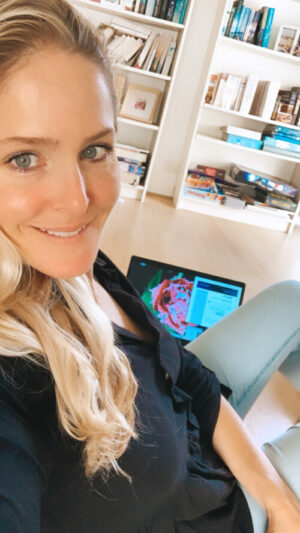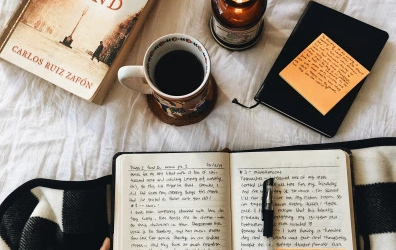It’s funny being asked to talk about how I go about writing my novels, because the truth is, I’ve never actually given it that much thought. I normally just get an idea, that idea grows and then I start writing. But having being asked HOW I do it has made actually consider that, yes, I probably DO have a way of writing.
Last year, when The Hidden never got picked up by a publisher, I wrote a whole novel called The Residents in 8 weeks. It’s a murder mystery story that my agent loved, but I didn’t love it enough to want it published. I didn’t want it to be THE debut novel. I think you’ve got to be careful about what book will become your debut novel, because the readers expectation of your work that follows should mirror that debut, or hopefully be better than the first. So I told my agent to hold off. I had a better idea. The Shallows.
I wrote The Shallows in 7 weeks. 83,000 words. I can hardly believe that now. There was such a huge determination in me that forced me to do it. I wanted to get published so badly, the urge is what drove me. And then, once I got my two-book deal, I felt like I could relax a little. The Rip came and came easily. Why? Possibly because I was starting to follow my own formula. Possibly because I understand I had time. Possibly because I wanted to take that time to do it right, knowing I now had a publisher relying on it.
Now I’m writing another novel, and again, it’s coming easily. So now I’ve been asked to share HOW I write and now I’ve reflected upon it.
- I get an idea. Normally it starts with a setting of some kind. My latest idea came from a birds-eye-view picture of a boat travelling along an isolated river, snaking its way through lush forest. Instantly, I was inspired. The Rip came from Rottnest Island and wondering why nothing bad has ever happened on the island. No murders (that I know of), no kidnapping – even though children roam freely. Clearly, I have a dark mind. My novels are setting and atmosphere heavy. So I really have to feel a place and then write about it. Atmosphere and setting are what create a mood in a reader, so if you get that right, the reader will be inside your story, feeling it and feeling it strongly.
- Once I know where it’s set, the conflict and characters come about almost straight away. I don’t know them fully yet, I just have to know why they’re there. What are they running from, what motivates them, what is their inner conflict (insecurities/anxieties/flaws/all the dark parts) and what are they afraid of losing? I have to know what’s going to happen to them (and this can change regularly).
- I go walking with my partner, who is also a writer and a prolific reader of everything. We met at university studying creative writing and he won first class honours for his writing. (He’s better than me. Really.) We walk and we talk plot for about two hours. This plotting part of the novel can last 2 weeks. We will call each other with an extra idea, or I will run things past him and once I know in my gut what’s right, realistic, convincing and true, I can start to write my synopsis and think about the ending. Often he will suggest ideas, and I just know how I envision the plot and what I need to do. So sometimes, I won’t agree with anything he says. LOL. But It’s just so important to have someone to “talk” through ideas with and have them question every motive and play the critic. ALWAYS QUESTION EVERY CHARACTERS MOTIVATION!!! ALWAYS.
- My characters become more 3D. The more I discuss my story, the more real they come. I know their background and what they despise and what they fear and how they speak. Again, this can change. Everything is up for change and being flexible.
- Now I know the ending, I can start writing. I don’t think. I don’t plan, but I always start with imagery and setting to get me and the reader in the mood. I start IN the conflict. Not ten years ago, not a week ago. You need to HOOK the reader/agent/publisher in straight away and that’s by starting in the conflict. I set atmosphere by selecting vocabulary that mirror the mood. My settings are normally tense and dark, even if they’re in a beautiful place. So I use words that signify that tension. Words like slap, smack, grip, choke, words that foreshadow and make the reader (and me) feel uncomfortable in that moment. It’s the subtext that creates emotion, so I always paint a bleak picture.
- In this stage of just writing, I’m still trying to figure out the character’s voice and how they sound. Too nice or too bitchy, arrogant or immature. I have to feel how they interact with one another and what they think about the other. So their voice can change and needs altering before I keep writing them.
- I write short chapters, sometimes only a page and a half. I don’t write in chapters, though, I write in scenes. Each scene is a movie in my mind, a stage-show. I start in the conflict and leave before it gets resolved. I always leave the reader (and me) hanging and wanting more. You have to excite yourself as much as the people who will be reading your story.
- I structure my novels peculiarly, again, to provoke the reader and make them feel uncomfortable and wary. I don’t want to be a reliable writer, or anyone the reader can trust. I want them to feel awkward and it’s in that awkwardness they’ll be tempted to keep reading. Because humans like disjointed, unusual and surprising things, even if it makes them feel weird. So I jump between timelines and just when you get used to one of them, I like to jump back. But each timeline has to be so good that the reader doesn’t mind being led astray.
- I get to about 10,000 words and then I follow a three act structure that the people in The Write Club have. It’s the best plot device because it reminds me when I need to reveal certain aspects of rising tension/conflict/resolutions etc. I break apart a 80,000 word novel and use a calculator to divide the sections into 3 parts. The last act is shorter than the other two, but I need to know what word count I begin the climax etc.
- I write out what needs to occur in those 3 acts and what the word count is for each act. For instance, by 20,000 I should have revealed this, this and this.
- Then I keep writing, never planning the scenes, just subconsciously knowing what needs to happen.
- When I reach the sagging middle (about 30,000 words in) I sometimes start planning out what’s going to happen every 2,000 words until the climax. This keeps me excited in the story, knowing what I have in front of me to look forward to. I write this in bullet points on a word doc. For instance:
- 61,000- Eloise finds the boat63,000- Rosie and Eloise swim out65,000- Wrong boat, but they find the real one.
- I’m always going back over the work. Not to edit, just to make sure I’m including everything I need to. I may be changing the narrative sometimes as I go along. Characters have a way of steering you away from the plot, and sometimes revealing things about themselves and their backstory that need to be included. So I will add scenes in and take scenes out.
- I make sure the last scene is as good as the first. It has to be memorable. I like to end my novels with a moral dilemma that has the reader questioning what they’d do in that situation.
- Once I’ve finished the first draft, I’ll go back over and read it (almost at a structural level), looking for scenes that need to be developed, or altered in structure. I’ll highlight them in red. They may need for me to dig deeper into a conflict, or to include more tension or to detail the setting. I just know they’re incomplete.
- Then I’ll read again at a sentence and word level. (But I’m really lucky because my partner edits my whole manuscript for grammar errors). He tightens the sentences and deletes unnecessary wording. Word choice, syntax and mood gets developed in this stage. I get Word Doc to read it out to me so I can hear the flow of it.
- I keep re-reading, checking for structure/inconsistencies in time/weather/days/what they’re wearing, drinking, eating etc.
- I read again, as a reader this time, adding in extra detail.
- My partner and beta-readers read as readers.
- I submit to my agent and the editing and re-reading process begins again!
- She submits to my publisher and the editing and re-reading happens once more. Phew!
I hope this helps anyone needing to know where to begin when writing a novel. It’s hard, time consuming, but the best feeling in the world when you finish that last sentence of the novel. You’ve created something. Now go and celebrate!
Holly x




0 Comments